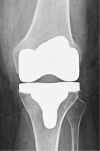Mobile bearing and fixed bearing total knee arthroplasty
- PMID: 27162777
- PMCID: PMC4842394
- DOI: 10.21037/atm.2015.12.64
Mobile bearing and fixed bearing total knee arthroplasty
Abstract
The mobile bearing (MB) concept in total knee arthroplasty (TKA) was developed as an alternative to fixed bearing (FB) implants in order to reduce wear and improve range of motion (ROM), especially focused on younger patients. Unfortunately, its theoretical advantages are still controversial. In this paper we exhibit a review of the more recent literature available comparing FB and MB designs in biomechanical and clinical aspects, including observational studies, clinical trials, national and international registries analyses, randomized controlled trials, meta-analyses and Cochrane reviews. Except for some minor aspects, none of the studies published so far has reported a significant improvement related to MBs regarding patient satisfaction, clinical, functional and radiological outcome or medium and long-term survivorship. Thus the presumed superiority of MBs over FBs appears largely inconsistent. The routine use of MB is not currently supported by adequate evidences; implant choice should be therefore made on the basis of other factors, including cost and surgeon experience.
Keywords: Clinical results; fixed bearing (FB); knee joint; mobile bearing (MB); total knee arthroplasty (TKA).
Conflict of interest statement
Figures



Similar articles
-
No differences between fixed- and mobile-bearing total knee arthroplasty.Knee Surg Sports Traumatol Arthrosc. 2017 Jun;25(6):1757-1777. doi: 10.1007/s00167-016-4195-x. Epub 2016 Jun 20. Knee Surg Sports Traumatol Arthrosc. 2017. PMID: 27324479 Review.
-
Mobile bearing total knee arthroplasty does not lead to better joint awareness compared to fixed bearing design: A systematic review and meta-analysis.J Exp Orthop. 2024 Dec 15;11(4):e70110. doi: 10.1002/jeo2.70110. eCollection 2024 Oct. J Exp Orthop. 2024. PMID: 39678021 Free PMC article. Review.
-
Mobile-bearing versus fixed-bearing total knee implants. Results of a series of 100 randomised cases after 9 years follow-up.Orthop Traumatol Surg Res. 2015 Jun;101(4 Suppl):S187-92. doi: 10.1016/j.otsr.2015.03.004. Epub 2015 Apr 15. Orthop Traumatol Surg Res. 2015. PMID: 25890808 Clinical Trial.
-
Mobile Bearing versus Fixed Bearing for Unicompartmental Arthroplasty in Monocompartmental Osteoarthritis of the Knee: A Meta-Analysis.J Clin Med. 2022 May 17;11(10):2837. doi: 10.3390/jcm11102837. J Clin Med. 2022. PMID: 35628963 Free PMC article. Review.
-
Fixed-bearing versus mobile-bearing total knee arthroplasty: a prospective randomised, clinical and radiological study with mid-term results at 7 years.Knee. 2008 Jun;15(3):206-10. doi: 10.1016/j.knee.2008.01.010. Epub 2008 Mar 10. Knee. 2008. PMID: 18329883 Clinical Trial.
Cited by
-
Low Response Rate to Follow-Up Using Telemedicine after Total Knee Replacement during the COVID-19 Pandemic in Italy.J Clin Med. 2024 Jan 9;13(2):360. doi: 10.3390/jcm13020360. J Clin Med. 2024. PMID: 38256494 Free PMC article.
-
Non-Sagittal Knee Joint Kinematics and Kinetics during Gait on Level and Sloped Grounds with Unicompartmental and Total Knee Arthroplasty Patients.PLoS One. 2016 Dec 21;11(12):e0168566. doi: 10.1371/journal.pone.0168566. eCollection 2016. PLoS One. 2016. PMID: 28002437 Free PMC article.
-
Comparative Study on Three Different Designs of Locking Mechanisms in Total Knee Arthroplasty.Bioengineering (Basel). 2025 Feb 10;12(2):169. doi: 10.3390/bioengineering12020169. Bioengineering (Basel). 2025. PMID: 40001688 Free PMC article.
-
Higher use of fixed-bearing over mobile-bearing and posterior-stabilized over medial pivot designs in total knee arthroplasty (TKA): a systematic comparative analysis using worldwide arthroplasty registers from England and Wales, Australia, Norway, New Zealand, Germany and Switzerland.Arch Orthop Trauma Surg. 2023 Feb;143(2):1021-1029. doi: 10.1007/s00402-022-04410-8. Epub 2022 Mar 18. Arch Orthop Trauma Surg. 2023. PMID: 35303145 Free PMC article.
-
Comparison of fixed and mobile-bearing total knee arthroplasty in terms of patellofemoral pain and function: a prospective, randomised, controlled trial.BMC Musculoskelet Disord. 2017 Jun 29;18(1):279. doi: 10.1186/s12891-017-1635-9. BMC Musculoskelet Disord. 2017. PMID: 28662692 Free PMC article. Clinical Trial.
References
-
- Callaghan JJ, Insall JN, Greenwald AS, et al. Mobile-bearing knee replacement: concepts and results. Instr Course Lect 2001;50:431-49. - PubMed
Publication types
LinkOut - more resources
Full Text Sources
Other Literature Sources
Miscellaneous
